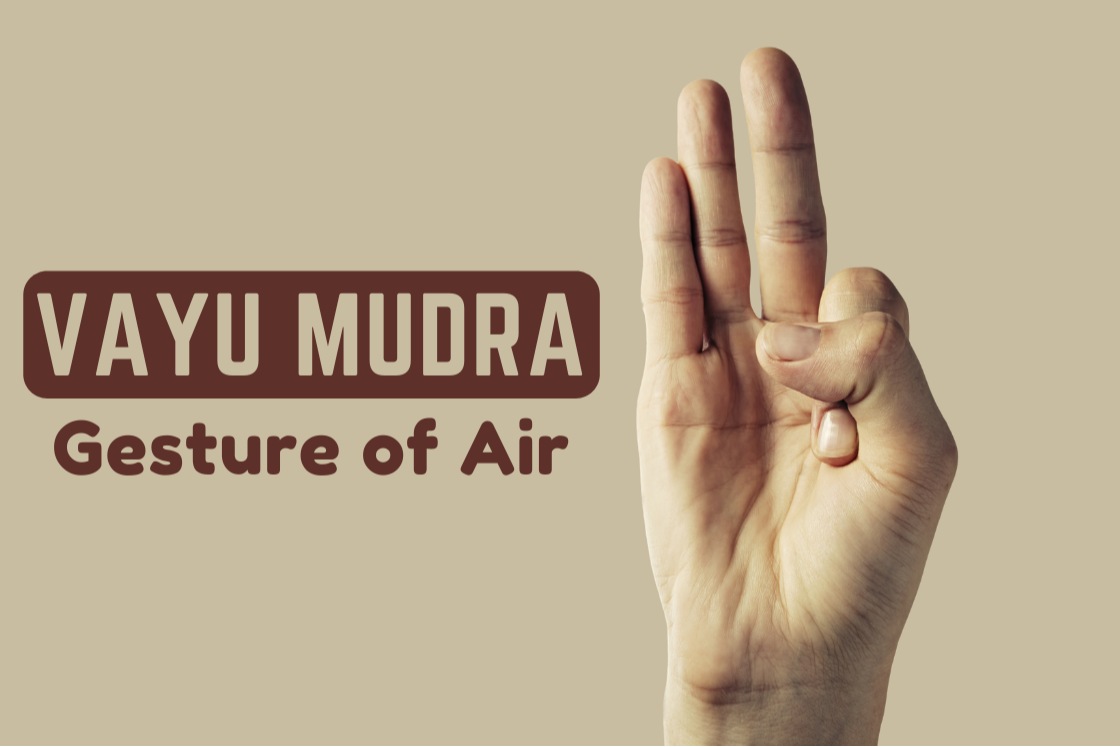
In yoga and Ayurveda, Vayu Mudra is a hand gesture used to balance the air element in your body. This ancient practice helps regulate the Vata dosha, which is responsible for movement and energy flow. Many people today experience stress and imbalance.
Adding Vayu Mudra to your daily routine can improve your health and well-being. It’s a simple gesture that can address issues like gas, bloating, and discomfort. Vayu Mudra is easy to do anywhere, making it a valuable part of your wellness routine. Learn how to perform Vayu Mudra and practice it safely.
Meaning
The term ‘Vayu Mudra’ comes from ancient Sanskrit, where ‘Vayu‘ means air and ‘Mudra‘ means gesture. This hand gesture helps balance the air element in the body, which is associated with the Vata dosha in Ayurveda. The Vata dosha controls movement and energy flow, impacting breathing, circulation, and digestion.
In Vayu Mudra, the thumb represents fire, and the index finger represents air. Pressing the index finger under the thumb allows the fire element to balance the air element. Ayurveda describes the body as having 49 types of Vayu, with five being vital and five subsidiary, each serving a specific function. Practicing Vayu Mudra helps regulate the flow of prana (energy) and balance the air element.
For best results, you can combine it with meditation or pranayama techniques to balance the Nadis, or subtle energy channels, and maintain smooth energy flow.
How To do Vayu Mudra(Steps)

- Sit comfortably in a posture like Sukhasana, Vajrasana, or Padmasana.
- Close your eyes and take deep breaths to stimulate prana flow.
- Place your palms facing upwards.
- Fold your index finger to touch the base of your thumb.
- Gently press your index finger with your thumb.
- Extend the rest of your fingers as much as possible.
- Place your hands on your thighs while keeping the gesture.Maintain steady, calm breathing and consider chanting OM to add a spiritual element to your practice
Note: The key difference between Vayu Mudra and Gyan Mudra is the finger placement. In Vayu Mudra, you touch the base of the thumb with the index finger. In Gyan Mudra, you touch the tip of the thumb with the index finger.
Time & duration
- Best Time: It’s ideal to practice Vayu Mudra in the morning when your stomach is empty. You can also do it during meditation or pranayama sessions.
- Duration: Start with 2 to 5 minutes per session and gradually increase to 15 to 30 minutes daily. You can split the practice into shorter segments if needed.
Precautions
- Avoid pressing too hard on your index finger with your thumb.
- Use gentle pressure to prevent discomfort.
- Ensure your index finger is comfortably touching the base of your thumb.
- Maintain a straight back while sitting.
- Adjust the pressure or position if you experience discomfort.
- Consult a healthcare provider if you have any medical conditions or concerns before starting.
Side effects
Vayu Mudra generally does not have significant side effects. Most people can practice it safely without adverse effects. However, if you experience any discomfort or unusual symptoms, it’s advisable to stop and consult a healthcare provider.
Vayu Mudra Benefits
- Reduces Symptoms of Parkinson’s Disease: Vayu Mudra may help reduce Parkinson’s disease symptoms by supporting nerve cell recovery and regeneration. Parkinson’s disease involves the loss of nerve cells in the substantia nigra, which decreases dopamine levels and impairs brain function. Practicing Vayu Mudra might assist in improving these conditions by aiding nerve cell repair.
- Stimulates Endocrine Glands: A malfunctioning endocrine system can cause issues like poor growth, metabolism problems, and hormonal imbalances. Vayu Mudra helps by directing energy to the brain and activating the hypothalamus, which in turn stimulates the endocrine glands and supports better overall function.
- Vayu Mudra for Gastric Problems: Vayu Mudra, also known as the Mudra of Air, is particularly effective for addressing gas-related issues. Practicing this mudra stimulates the part of the brain linked to the Vagus nerve, which regulates the Vata (Air) Dosha. This helps manage conditions such as flatulence, indigestion, and acid reflux, making Vayu Mudra an effective remedy for gastric problems.
- Builds Immunity: Frequent infections, colds, or flu can indicate a weak immune system, which may lead to serious health issues if left untreated. Ayurveda notes that gently touching specific pressure points on the index finger creates an energetic wave in the body. This stimulates and strengthens the immune system components, such as antibodies, lymphocytes, and white blood cells, enhancing overall immunity over time.
- Find Calm and Happiness: In today’s busy world, stress and unhappiness are common due to constant work and personal pressures. Practicing Vayu Mudra during meditation or pranayama can help bring back calm and happiness.
Conclusion
Vayu Mudra is a valuable practice for balancing the air element in the body and addressing various health issues. By incorporating this simple gesture into your daily routine, you can manage gastric problems, boost immunity, support endocrine health, and achieve mental peace. As with any practice, consistency and mindful execution are key to reaping its full benefits.

